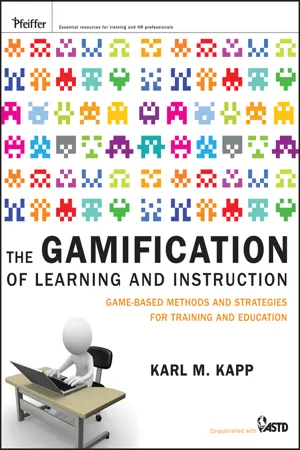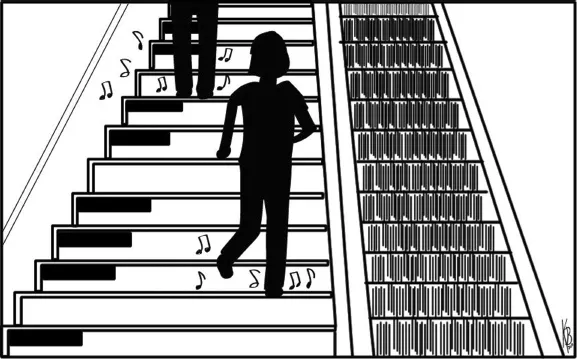![]()
Chapter 1
What Is Gamification?
CHAPTER QUESTIONS
At the end of this chapter, you should be able to answer these questions:
- What is a game?
- What is gamification?
- What are three examples of adding game-based elements to traditional learning environments to improve learning and retention?
- What are the advantages of using game-based techniques for the creation and implementation of performance improvement initiatives?
Introduction
You have ten seconds.
Name three countries that begin with the letter “U.” Go.
Ten, nine, eight, seven, six, five, four, three, two, one. Hint, check Endnote 1 for answers.1
How did you do? Did you get the obvious one? Did you get all three? Did you get more than three? Did you turn to the back of the book? Did answers pop into your head? If you tried to answer the question or looked in the back of the book, you experienced gamification.
People like playing games; they are fun and engaging. In fact, a recent survey showed that 55 percent of people would be interested in working for a company that offered games as a way to increase productivity.2 So maybe your vision of gamification is rewards, badges, and points for doing everyday stuff at work or even for brushing your teeth. But that’s a narrow way of looking at gamification; a broader, more encompassing and more helpful way of looking at gamification exists.
Following are several examples of concepts that fit with my definition of gamification. See whether you can develop a definition of the term before one is provided in the text. Or see whether your concept of gamification is the same concept discussed in this book . . . but be prepared, it may not be. Ready, set . . . go.
Gamification in Action
Lack of physical activity is a growing challenge putting millions of people at risk, but it’s not due to a lack of information or knowledge. Plenty of people know they should exercise and can recite all the benefits of physical activity when asked. But sadly, this knowledge is not reflected in their behavior. Few people exercise or even elect extra physical activity when given the opportunity. For instance, many people exiting a subway take the escalator to get to street level rather than the stairs, even when the escalator is busy and the stairs empty. But all that changed in one town when they transformed a subway exiting staircase into a set of black and white piano keys, each step producing a different musical note when stepped on, as depicted in Figure 1.1. After the piano-type steps were installed, behavior changed. People started to engage with the keys and elected to take the stairs making music as they entered and exited the subway station. The use of the staircase increased 66 percent.3
Running was never a favorite activity of Rachel’s; she didn’t like to run in the rain or cold, or even if when it was hot or muggy. She couldn’t bring herself to jump out of bed in the morning, put on a pair of running shoes, and pound the pavement; she just wasn’t that into it. Until she downloaded Zombies, Run! The mobile application changed everything.
It wasn’t an ordinary application to track running time, number of miles completed, and pacing, Sure, it tracked all that, but it also involved her in an interactive game. As she runs, she plays the role of a character known as Runner 5. Her job is to go out into a zombie-infested post-apocalyptic environment and collect supplies to bring back to her home base.
She puts on her headphones, starts the application and, as she is running, the application periodically indicates when she has collected key items required to support her virtual base. It also warns her when zombie hordes are closing in and she needs to increase her speed. Several times a run, she finds herself chased by zombies and unknowingly doing interval training. All the while, the application records her pace and number of miles; when she returns home, she uploads the information to a website to track her progress. She also tracks the rebuilding of her base using items collects during her run.
Now she can’t wait to run. She is actively engaged in the story, and her running miles have increased over the past few months as she finds herself running more so she can rebuild her base faster and find out her next mission as Runner 5.4
Sam knows first-hand just how dangerous it can be working on a loading dock. One day, he was unloading product from a delivery truck with his 9,000 pound forklift when he forgot to check behind him as he backed up. What he didn’t see was that a co-worker had placed a stack of pallets immediately behind him blocking his right-of-way. As Sam’s forklift moved backward, it caught the edge of the pallet and began to tip. Instinctively, Sam tried to jump out of the forklift. Unfortunately, his foot caught, the forklift tipped all the way over on landed on him. He saw himself being killed instantly.
Sam wasn’t hurt—not even a scratch. Of course, he did lose one life and 100 life points for his mistake, which made him mad because it dropped his standings in the virtual safety leaderboard. Sam was driving a virtual forklift in a virtual networked simulated environment with an instructor and four other trainees. The entire incident took place online as part of a training activity. After the incident, the instructor used the opportunity to explain to the group several points of forklift and loading dock safety. To this day, Sam has never had a safety incident on an actual loading dock. He contributes that record partly to the training he has received in the loading dock simulator.5
Professor Jones, a new faculty member at a large university, teaches large classes. She has over three hundred students per class but, on average, her students have almost 100 percent attendance. Other faculty members marvel at how she is able to accomplish this task because many students use large classes are an excuse to cut class. But to Professor Jones, the process is simple. Each class period she tracks attendance, demands student interactivity, and evaluates the quality of each and every student’s answer to questions she poses during her lectures. Students log onto a website and see their progress against themselves and others on a class leader board. Professor Jones uses an audience response system to make the process for three hundred students manageable.
Every student is assigned a response pad at the beginning of the semester containing his or her student identification number. In every class, Professor Jones poses dozens of questions from the reading interspersed into her lecture. Students respond by clicking a button that corresponds to an answer. The results are instantly loaded to the class website, and students track how they are doing in real time.
Elizabeth’s organization is the envy of many. Its members never have to actively recruit; people come to them, drawn by their reputation, and the ones who fit well and make a positive contribution end up being welcomed into the group. Elizabeth has learned from other start-ups the importance of good communication and giving everyone a common vision he or she can believe in. She is a good day-to-day manager but is also careful to step aside and allow others the opportunity to lead. She is charismatic by nature, but uses this strength to make everyone on the team feel like part of something special, rather than hogging the spotlight. When there’s a disagreement, everyone on the team knows that she can be counted on to be fair and practical.
She credits her abilities with learning from other leaders. Remembering the first person to promote her into a management position, she says, “This guy was amazing. . . . Everyone loved him. No one could argue with him. And I learned it wasn’t just because he was a leader. It was his attitude. He was always open to other ideas, but he also knew how to stick firmly to something he knew would work. It’s not about being able to force people to do what you want to them to do; it’s about getting people to try what you want and seeing how things work, and staying open to new ideas.”
By the time Elizabeth was promoted to her first management position at work, she had years of management and leadership experience from leading one of the most successful guilds on her World of Warcraft server.6
Emanuel’s factory wasn’t doing well. The team members were working as quickly as they could, but they never got ahead of their problems. The plastic inventory components were stacked up around the work centers, customer satisfaction rates were low, and product wasn’t flowing through the factory in a timely manner. The only consolation was that none of the competitors’ factories looked much better. Emanuel’s frustration level was beginning to grow and he could feel himself getting angry; he just didn’t know how to improve production. It was at this time that the instructor stepped in and explained to the four teams sitting around the lean manufacturing game boards how they could improve.
The instructor from a lean manufacturing consulting firm demonstrated techniques for streamlining the factory floor layout on the game board and provided ideas for moving materials from work cell to work cell based on upstream demand and not simply meeting a quota. After the demonstration by the instructor, Emanuel and his fellow teammates reconfigured their mock factory and moved their plastic inventory pieces based on the new advice. During this process, something became glaringly obvious to Emanuel. Quickly moving inventory from work center to work center wasn’t as productive as only moving inventory when the downstream work center need it. Emanuel had read that advice and heard it spoken by instructors, but he never really understood or trusted that idea until he witnessed the dramatic results during the playing of the game. Four weeks later, the product line Emanuel supervised benefited from his new insight by waiting for downstream demand before producing the needed inventory. Production on Emanuel’s line increased by 20 percent, while scrap decreased by 15 percent.
Are these concepts you think of when you hear the term “gamification,” or are you still thinking rewards, badges, and points?
What Is a Game?
Before we can go too much further in describing or defining the concept of gamification, we must first define the root of the word gamification. What is a game? There have been many different definitions and attempts at defining the term “game,” but I think one of the closest definitions for application in an instructional setting was put forth by Katie Salen and Eric Zimmerman in their book Rules of Play: Game Design Fundamentals.
Even this excellent definition needs to be modified to fit a learning context, let’s replace few words from their original definition and ad...

